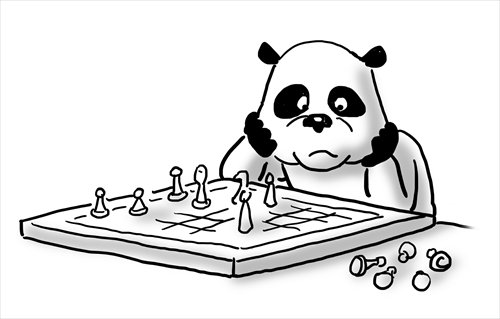
Illustration: Liu Rui/GT
The late night of July 13, 1953 witnessed one of the last battles of the Korean War - the Battle of the Kumsong River, also known as the Jincheng Campaign. Chinese troops marched forward toward the first cavalry regiment of the South Korean capital division. Amid the huge offensive, a small group of Chinese soldiers launched a surgical strike on and wiped out the elite South Korean White Tiger regimental headquarters.
The destruction of the White Tiger regiment became a classic scene in Chinese cinema and opera, depicted as a small-scale raid by a small group of Chinese soldiers under platoon leader Yang Yucai. It soon became a widely-known tale in China, which fully demonstrated the Chinese army's intelligent and courageous combat capabilities. The story also turned into a classic case of a surgical strike in modern warfare.
The battle of over 60 years ago crossed my mind after I saw the news over Washington and Seoul's decision on deploying the Terminal High-Altitude Area Defense (THAAD) system in South Korea. The system is designed to monitor the enemy's ballistic missiles, in order to intercept and shoot down missiles. THAAD is only a defense system, but in war, the best offense needs the best defense behind it.
According to South Korea, THAAD has a range of over 200 kilometers, which can reach the Shandong Peninsula in China and parts of the Sino-North Korean border. It appears not a big threat to China, yet once deployed, it will be much easier to upgrade the system. By then, a large proportion of Northeast China, North China and East China will be exposed to the US military.
However, in modern combats, this shield is not almighty. First of all, it will become the primary target of attacks by enemies. If the US ever uses the system against China, the possibility of it being struck down in a surgical strike cannot be ruled out.
Nowadays, even with highly developed military technologies, surgical strike is still frequently used. With the development of military technologies and equipment, the tools and means of surgical strike are also becoming more various and more complicated. Apart from air-delivered special forces, drones and cruise missiles have also turned into common choices of surgical strike.
The deployment of THAAD will speed up the missile technology and research development in the countries which feel threatened. And they will likely develop more sharp and more flexible missiles that are harder to defend against. For instance, Russia has already settled on placing its latest advanced missile defense system on the Kuril Islands.
On the surface, it seems like that the deployment of the THAAD system in South Korea is a decision made as a countermeasure against Pyongyang's nuclear tests. As matter of fact, it has long been a vital link of US global strategic control in crucial regions.
The White House is utilizing the situation on the Korean Peninsula to promote its deployment of THAAD, in order to gain strategic dominance in Northeast Asia and consolidate the US-led order in the Asia-Pacific region. How the tensions on the peninsula develop depends on how Pyongyang will respond. But the biggest trouble is that no one can be sure of North Korea's intentions.
Through deployment of the THAAD system, the US is enhancing its alliance with South Korea and Japan. Washington has been trying to grasp strategic dominance in Northeast Asia, and the Korean Peninsula issue has always been a vital part of US China policy.
Hence, the US pondered THAAD deployment from the perspective of its strategy toward Beijing. This will without doubt escalate the strategic competition between Beijing and Washington along China's periphery.
The balance of China's peripheral situation is leaning toward the US. Destroying or restraining the THAAD system may not be too hard technologically. And China has the military wisdom and courage to launch a surgical strike.
Yet given the escalating tensions in the South China Sea and Northeast Asia in the game between China and the US, Beijing will face the double challenge of not only fighting back against provocations, but also contributing to build a favorable neighboring environment. How to coordinate its effort in both fields will prove to be the real test that confronts China.
The author is a senior editor with People's Daily, and currently a senior fellow with the Chongyang Institute for Financial Studies at Renmin University of China.
dinggang@globaltimes.com.cn Follow him on Twitter at @dinggangchina




